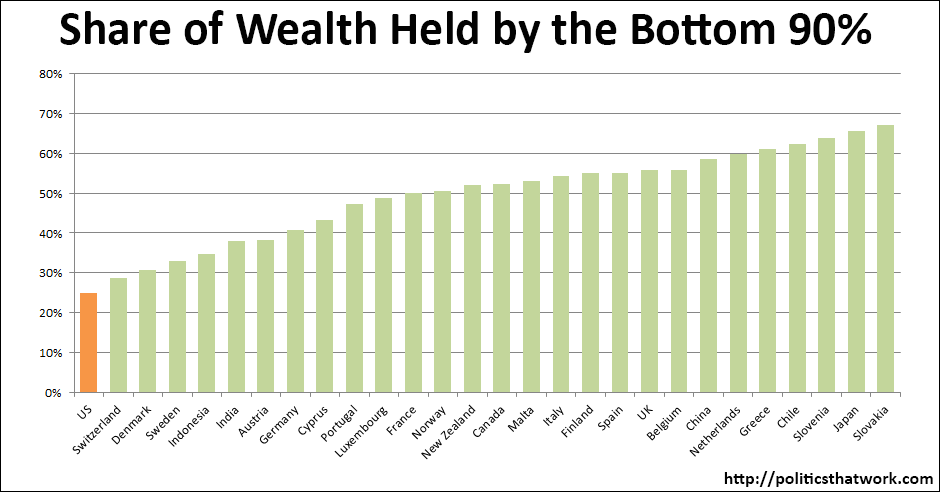
The Bottom 90% of Americans Own the Smallest Portion of the Nation's Wealth of Any Country That Tracks It
Description: This graph shows the portion of each country's wealth that is owned by the least-wealthy 90% of that country's population. Every country that tracks the distribution of wealth in sufficiently precise increments is listed.
Sources: Credit Suisse (aggregating data from national records)
Data: Excel
Last updated: May 12, 2016
Related blog post: Inequality in America
Discussion: Wealth is more concentrated in the United States than in any other country that tracks the distribution of wealth. If the United States' distribution of wealth became even as equal as the second-worst country (Switzerland), 90% of Americans would see their net worths increase by 16%. If the distribution of wealth in the U.S. matched the distribution in Japan, the net worths of 90% of Americans would increase by 168%.
The result is that, although the United States is one of the very wealthiest countries, typical Americans have significantly less wealth than typical people do in most wealthy countries.
Wealth has always been unusually concentrated in the United States, but it has not been this extreme since the Great Depression. If the United States were to return to the distribution of wealth it had 30 years ago, 90% of Americans would have 44% more wealth than they do today. The drop in the wealth of the bottom 90% is almost entirely a function of the dramatic increase in the share of wealth held by the top 1% since 1980.
There are many causes of wealth inequality in the U.S. One cause is the low level of safety net spending in the U.S. Another is conservative economic policy. Most fundamentally, however, employers in the U.S. keep an enormous share of the productivity of their workers today. That has not always been the case.
The level of wealth concentration does not appear to correlate directly to the prosperity of the country. Some highly concentrated countries are wealthy (e.g., U.S. and Switzerland) while others are less-wealthy (e.g., Indonesia and India). Conversely, some more equal countries are wealthy (e.g., Japan and the Netherlands), while others are less-wealthy (e.g., Slovakia and China).
See more graphs about: Wealth Inequality
Discussion: Wealth is more concentrated in the United States than in any other country that tracks the distribution of wealth. If the United States' distribution of wealth became even as equal as the second-worst country (Switzerland), 90% of Americans would see their net worths increase by 16%. If the distribution of wealth in the U.S. matched the distribution in Japan, the net worths of 90% of Americans would increase by 168%.
The result is that, although the United States is one of the very wealthiest countries, typical Americans have significantly less wealth than typical people do in most wealthy countries.
Wealth has always been unusually concentrated in the United States, but it has not been this extreme since the Great Depression. If the United States were to return to the distribution of wealth it had 30 years ago, 90% of Americans would have 44% more wealth than they do today. The drop in the wealth of the bottom 90% is almost entirely a function of the dramatic increase in the share of wealth held by the top 1% since 1980.
There are many causes of wealth inequality in the U.S. One cause is the low level of safety net spending in the U.S. Another is conservative economic policy. Most fundamentally, however, employers in the U.S. keep an enormous share of the productivity of their workers today. That has not always been the case.
The level of wealth concentration does not appear to correlate directly to the prosperity of the country. Some highly concentrated countries are wealthy (e.g., U.S. and Switzerland) while others are less-wealthy (e.g., Indonesia and India). Conversely, some more equal countries are wealthy (e.g., Japan and the Netherlands), while others are less-wealthy (e.g., Slovakia and China).
See more graphs about: Wealth Inequality
Political and Economic News
EPI: The Tax Cuts and Jobs Act isn’t working and there’s no reason to think that will change
CNN: Trump ordered Mattis to screw Amazon
Elijah Cummings: We are in a fight for the soul of our democracy
Pro Market: The Cost of America’s Oligopoly Problem
...more





